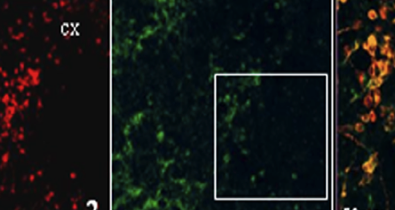WEDNESDAY AUGUST 13, 2008
ISCHEMIA-INDUCED NEUROBLAST ACTIVATION: A MATH MODEL

The best characterized region which sustains adult neurogenesis is the subventricular zone. This is the region which contributes to the regeneration of interneurons in the olfactory bulb. Under certain pathological condition, this zone can also contribute to neurogenesis for damaged structures such as the cerebral cortex after cerebral ischemia or Alzheimer disease, or the striatum in an animal model of Parkinson's disease
We have developed a rat brain organotypic culture model, in which tissue slices contain cortex-subventricular zone-striatum regions, to model neuroblast activity in response to in vitro ischemia. Neuroblast activation has been described in terms of two main parameters, proliferation and migration from the subventricular zone into the injured cortex. We observed distinct phases of neuroblast activation as is known to occur after in vivo ischemia. Thus, immediately after oxygen/glucose deprivation (6–24 hours), neuroblasts reduce their proliferative and migratory activity, whereas, at longer time points after the insult (2 to 5 days), they start to proliferate and migrate into the damaged cortex. Antagonism of ionotropic receptors for extracellular ATP during and after the insult unmasks an early activation of neuroblasts in the subventricular zone, which responded with a rapid and intense migration of neuroblasts into the damaged cortex (within 24 hours). The process is further enhanced by elevating the production of the chemoattractant SDf-1α and may also be boosted by blocking the activation of microglia. This organotypic model which we have developed is an excellent in vitro system to study neurogenesis after ischemia and other neurodegenerative diseases. Its application has revealed a SOS response to oxygen/glucose deprivation, which is inhibited by unfavorable conditions due to the ischemic environment. Finally, experimental quantifications have allowed us to elaborate a mathematical model to describe neuroblast activation and to develop a computer simulation which should have promising applications for the screening of drug candidates for novel therapies of ischemia-related pathologies.
Vergni D, Castiglione F, Briani M, Middei S, Alberdi E, et al. 2009 A Model of Ischemia-Induced Neuroblast Activation in the Adult Subventricular Zone. PLoS ONE 4(4): e5278. doi:10.1371/journal.pone.0005278
Web articles on this work (in italian)(basically it is the same article reported many times ...)
...
STUDY